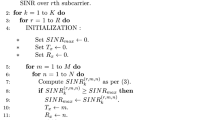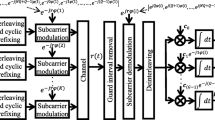Abstract
This paper analyzes the performance of cyclic prefixed single-carrier transmission under multiuser interference (MUI). For multi-user receivers using single carrier frequency domain adaptive antenna array, we derive the signal to interference plus noise ratio by analyzing the time domain estimated signal after the transformation from frequency domain to time domain. By assuming the MUI follows the Gaussian distribution, we can derive the analytical expression for the bit error rate (BER) performance. The analytical result is verified by the numerical results generated by Monte Carlo method. It is concluded from the analytical results that if the number of receive antennas goes to infinity as assumed in massive multiple input multiple output (MIMO) system, the BER performance will be determined by two ratios: signal to noise ratio as well as the N r to U ratio, where N r is the number of receive antennas and U is the number of users.
Similar content being viewed by others
References
Proakis J. Digital Communications. 4th ed. New York: McGraw-Hill, 2001
Wang Z, Giannakis G B. Wireless multicarrier communications: where Fourier meets Shannon. IEEE Signal Process Mag, 2000, 47: 29–48
Zhu H L, Wang J Z. Chunk-based resource allocation in OFDMA systems—Part I: chunk allocation. IEEE Trans Commun, 2009, 57: 2734–2744
Zhu H L, Wang J Z. Chunk-based resource allocation in OFDMA systems—Part II: joint chunk, power and bit allocation. IEEE Trans Commun, 2012, 60: 499–509
Zhu H L. Radio resource allocation for OFDMA systems in high speed environments. IEEE J Sel Areas Commun, 2012, 30: 748–759
Li M Q, Rui Y. Analysis of CFO effects and phase compensation method for SC-FDMA systems. Sci China Ser-F: Inf Sci, 2009, 52: 2397–2405
Wang Z D, Ma X L, Giannakis G B. OFDM or single-carrier block transmissions? IEEE Trans Commun, 2004, 52: 380–394
Ohno S. Performance of single-carrier block transmissions over multipath fading channels with linear equalization. IEEE Trans Signal Process, 2006, 54: 3678–3687
Muquet B, Wang Z D, Giannakis G B, et al. Cyclic prefixed or zero padded multicarrier transmissions? IEEE Trans Commun, 2002, 50: 2136–2148
Kaleh G K. Channel equalization for block transmission systems. IEEE J Sel Areas Commun, 1995, 13: 110–121
Qureshi S U H. Adaptive equalization. Proc IEEE, 1985, 73: 1349–1387
Forney G D. Maximum-likelihood sequence estimation of digital sequences in the presence of inter-symbol interference. IEEE Trans Inform Theory, 1972, 18: 363–378
Falconer D, Ariyavisitakul S L, Benyamin-Seeyar A, et al. Frequency domain equalization for single-carrier broadband wireless systems. IEEE Commun Mag, 2002, 40: 58–66
Liu R, Gao X Q, Wang W J. A Sub-block orthogonal single carrier frequency domain equalization system in fast Rayleigh fading channel. Sci China Inf Sci, 2010, 53: 1833–1847
Peng W, Adachi F. Frequency domain adaptive antenna array for broadband single-carrier uplink transmission. IEICE Trans Commun, 2011, E94-B: 2003–2012
Peng W, Adachi F, Wang X D, et al. Spectrum efficiency analysis and adaptive transceiver design for single-carrier multi-user transmission. IEEE Trans Veh Technol, 2015, 64: 3566–3577
Ghosh A, Ratasuk R, Mondal B, et al. LTE-advanced: next-generation wireless broadband technology. IEEE Trans Wirel Commun, 2010, 17: 10–12
Prasad N, Wang S Q, Wang X D. Efficient receiver algorithms for DFT-spread OFDM systems. IEEE Trans Wirel Commun, 2009, 8: 3216–3225
Myung H G, Lim J, Goodman D J. Single carrier FDMA for uplink wireless transmission. IEEE Veh Technol Mag, 2006, 1: 30–38
Iwamura M, Etemad K, Fong M, et al. Carrier aggregation framework in 3GPP LTE-Advanced. IEEE Commun Mag, 2010, 48: 60–67
Mendicute M, Altuna J, Atxa V, et al. Performance comparison of OFDM and FDE single-carrier modulation for spatial multiplexing MIMO systems. In: Proceedings of IEEE 5thWorkshop on Signal Processing Advances in Wireless Communications, Lisbon, 2004. 532–535
Khan U, Baig S, Mughal M J. Performance comparison of single carrier modulation with frequency domain equalization and OFDM for wireless communications. In: Proceedings of International Conference on Emerging Technologies, Islamabad, 2009. 297–300
Kim K J, Tsiftsis T A. Performance analysis of QRD-based cyclically prefixed single-carrier transmissions with opportunistic scheduling. IEEE Trans Veh Technol, 2011, 60: 328–333
Adachi F, Takeda K. Bit error rate analysis of DS-CDMA with joint frequency-domain equalization and antenna diversity combining. IEICE Trans Commun, 2004, E87-B: 2991–3002
Kelkar S S, Grigsby L L, Langsner J. An extension of Parseval’s theorem and its use in calculating transient energy in the frequency domain. IEEE Trans Ind Electron, 1993, IE-30: 42–45
Haykin S. Adaptive Filter Theory. 4th ed. Englewood Cliffs: Prentice-Hall, 2000
Franklin M. Matrix Theory. New York: Dover, 2000
Marzetta T L. Noncooperative cellular wireless with unlimited number of base station antennas. IEEE Trans Wirel Commun, 2010, 9: 3590–3600
Author information
Authors and Affiliations
Corresponding author
Rights and permissions
About this article
Cite this article
Peng, W., Zhou, Q.F., Huang, A. et al. From frequency domain to time domain: performance analysis on cyclic prefixed multi-user single-carrier transmission. Sci. China Inf. Sci. 59, 082302 (2016). https://doi.org/10.1007/s11432-015-5374-y
Received:
Accepted:
Published:
DOI: https://doi.org/10.1007/s11432-015-5374-y




